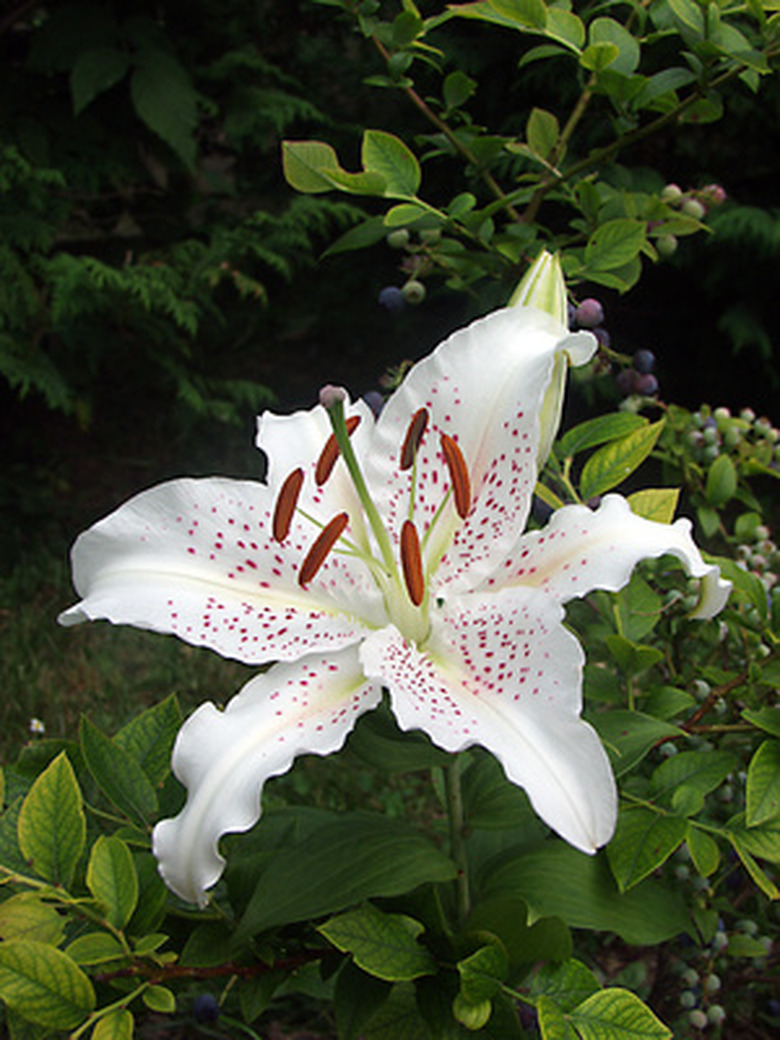What Is The Function Of Ovaries Of Flowers?
In angiosperms, or fruit-producing plants, the female part of a flower is called the pistil. The _ovary _of a flower is located at the base of the pistil. The primary ovary function is to protect the ovules. In many plants, after pollination, the ovary swells to form the fleshy part of a fruit. Gymnosperms lack an ovary and therefore do not produce fruiting bodies.
Ovary of a Flower: Functions
Ovary of a Flower: Functions
The initial function of an ovary in a flower is to protect the ovules. The ovules house the female reproductive gametes, nutrients for plant embryo development and protective layers. After pollination, the ovary protects the developing seed embryos by swelling to form fruit, then aids in dispersing the mature seeds.
Ovary of a Flower: Location
Ovary of a Flower: Location
Look at a cross-section of a flower. If the ovary is at the very base of the flower, below the origin points of the petals and sepals, this is called an inferior ovary. Inferior ovaries are common in the daisy (Asteraceae) family. Mallow (Malva sylvestris) flowers are a good example of superior ovaries. This is when the petals, sepals and stamens come up from underneath and then close around the ovary. In a subsuperior or half-inferior ovary, as seen in roses (Rosa spp.), the petals and sepals appear to originate from about halfway down the ovary.
Ovary of a Flower: Structure
Ovary of a Flower: Structure
A plant's ovary is an enclosed structure. Inside the ovary are one or more cavities, called carpels. The carpels hold an ovule or multiple ovules, which contain the egg cells. During pollination, the sperm cells enter the ovary tissues through pollen tubes. The growing pollen tubes are guided by chemical signals emitted from the egg cells and tissues within the pistil.
The ovary tissues are also involved in preventing sperm with certain genetic mutations from entering. By selecting which sperm cells can pollinate the egg cells, the ovary protects embryos from developing genetic mutations that may lead to infertility. Researchers have identified that pollen must contain a gene called NO TRANSMITTING TRACT (NTT) to pass through the ovary tissues in the plant genus Arabidopsis.
Ovary of a Flower: Development
Ovary of a Flower: Development
Different ovary arrangements result in many different types of fruit. Drupe fruits like plums or cherries (Prunus spp.) are formed from flowers with one ovary and a single ovule. Other fruits, such as tomatoes (Solanum lycopersicum), develop from a single ovary with many ovules. A fruit called an infructescence, such as a fig ( Ficus carica), is formed from multiple flowers, each with fertilized ovaries. An aggregate fruit, like blackberry or raspberry (Rubus spp.), is a bunch of individual ripened ovaries, each with one ovule.
Animal Dispersal of Fruit and Seeds
Animal Dispersal of Fruit and Seeds
Plants that have evolved to use animals to disperse their seeds use fruit – swollen ovaries – as an attractive food source and reward. The fruit plays a vital role in signaling to animals when it is ready to be eaten. Immature fruit tends to be green, hard and bitter tasting. Once the seed has matured and is ready for dispersal, most fruits turn red, purple or orange and are soft and sweet tasting to lure animals in.
Sometimes the animal helps spread the seeds by manually moving them to new locations. For example, squirrels leave forgotten caches of buried nuts that eventually grow into trees. Many plants disperse their seeds in an animal's feces so they will arrive at a new location – an example is red yew berries eaten whole by badgers. Other seeds need to move through an animal's digestive system to break down their protective outer shells before they can germinate. When seeds move through birds, their gizzards and digestive chemicals help to break down the hard outer shell.
Explosive Seed Dispersal
Explosive Seed Dispersal
Instead of developing into a plump, juicy fruit for animal dispersal, some plant ovaries dry out. In plants like peas, flax and gorse, their seed pods explode in hot, dry conditions. This popping action shoots the seeds away from the parent plant.
References
- Digital Atlas of Ancient Life: Fruits
- Illinois Extension: Angiosperms vs Gymnosperms
- Food and Agriculture Organization: Seed and Fruit Development, Germination, Dormancy
- Annals of Botany: Angiosperm Ovules: Diversity, Development, Evolution
- Kew: How Plants Hitchhike on Animal Poo
- Science Learning Hub: Seed Dispersal
- Current Biology: The Formation and Function of the Female Reproductive Tract in Flowering Plants
- Lizzie Harper: The Ovary in Botany
Cite This Article
MLA
Jerrett, Adrianne. "What Is The Function Of Ovaries Of Flowers?" sciencing.com, https://www.sciencing.com/what-is-the-function-of-ovaries-of-flowers-13426321/. 30 September 2021.
APA
Jerrett, Adrianne. (2021, September 30). What Is The Function Of Ovaries Of Flowers?. sciencing.com. Retrieved from https://www.sciencing.com/what-is-the-function-of-ovaries-of-flowers-13426321/
Chicago
Jerrett, Adrianne. What Is The Function Of Ovaries Of Flowers? last modified August 30, 2022. https://www.sciencing.com/what-is-the-function-of-ovaries-of-flowers-13426321/
